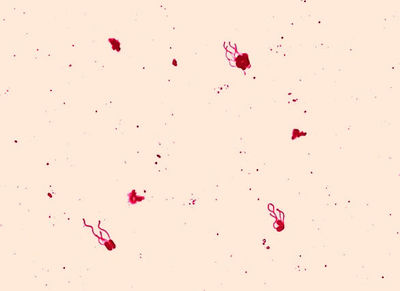Alcaligenes faecalis NEUF2011
A Microbial Biorealm page on the genus Alcaligenes faecalis NEUF2011

Leifson flagella stain of Alcaligenes faecalis (digitally colorized). Photograph by CDC/Dr. William A. Clark (1).
Classification
Higher order taxa
- Domain: Bacteria
- Phylum: Proteobacteria
- Class: Beta Proteobacteria
- Order: Burkholderiales
- Family: Alcaligenaceae
- Order: Burkholderiales
- Class: Beta Proteobacteria
- Phylum: Proteobacteria
Species
- Genus: Alcaligenes
- Species: faecalis
Alcaligenes faecalis
Description and significance
Alcaligenes faecalis occur in water and soil. The microbe has peritrichous flagellar arrangement which allows for motility (2). It is a gram-negative, rod-shaped organism observed at 0.5-1.0 μm x 0.5-2.6 μm in diameter. An aerobic microbe, A. faecalis is optimal at temperatures between 20-37 °C (3).
This microbe is most commonly seen in the clinical laboratory. Most infections caused by A. faecalis are opportunistic and acquired from moist items such as nebulizers, respirators, and lavage fluids. When an infection occurs, it is usually in the form of a urinary tract infection (2). However, A. faecalis is also known to be the pathogen that causes bacterial keratitis and postoperative endophthalmitis. Numerous strains have been isolated from clinical material such as blood, urine and feces (3).
As seen in a study on metabolic energy in Alcaligenes faecalis, it was found that the microbe survives in cultures of 10 g/L of aqueous arsenic. The observed thriving of the microbe in arsenic is important in bioremediation of environments contaminated with aqueous arsenic (4). In environments with high arsenic, the community must be wary of the likely presence of A. faecalis and its tendency to cause infections.
Genome structure
Describe the size and content of the genome. How many chromosomes? Circular or linear? Other interesting features? What is known about its sequence?
Cell structure and metabolism
As Alcaligenes faecalis is a gram-negative bacterium, it possesses an outer membrane, a thin (compared to gram-positive bacteria) peptidoglycan layer, and a periplasm. These three layers form the gram-negative cell envelope.
Alcaligenes faecalis is unusual among gram-negative bacteria for it's ability to aerobically desaturate saturated fatty acids in order to produce monosaturated fatty acids (3). Higher-order organisms such as animals, protozoa, and various types of algae have this ability, while most bacteria and almost all gram-negative bacteria use an anaerobic pathway. Alcaligenes faecalis has also demonstrated the ability to enzymatically metabolize arsenite (AsO2-, oxidation state +3) to the less harmful arsenate (AsO4-, oxidation state +5). This bacterium could be useful for neutralization of environments contaminated by arsenite.
Ecology
Habitat; symbiosis; contributions to the environment.
Pathology
How does this organism cause disease? Human, animal, plant hosts? Virulence factors, as well as patient symptoms.
Current Research
- Crude biosurfactant from thermophilic Alcaligenes faecalis: Feasibility in petro-spill bioremediation
Cool Factor
Describe something you fing "cool" about this microbe.
References
1. "Alcaligenes faecalis. Leifson flagella stain (digitally colorized)." CDC/Dr. William A. Clark 1976.
2. Winn, W., Sommers, H., Koneman, E., Janda, W., Dowell, V., and Allen, S. "Color Atlas and Textbook of Diagnostic Microbiology". 'J.B. Lippincott Company'. 1988. Edition 3. p. 184, 200-201.
- Created and Edited by Kevin Wieczerza, Stephanie Freed, Amanda McKenzie, Hughes Burridge -- Students of Dr. Iris Keren
